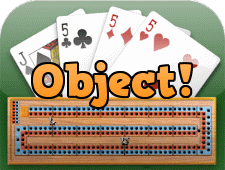
1: OBJECT OF THE GAME..
Be the first player to score 121 points or 61 when playing regular crib to win depending on game length selected at start. ( Lowball tournies see tourney page rules ).
2: NUMBER OF PLAYERS.
The basic game is for two players, and these rules apply to the two-handed game. Four-handed versions of the game are played with essentially the same rules.
3: THE CARDS.
A standard pack of 52 playing cards is used. (Jokers are discarded.)
The four suits are considered equal.
The rank and value of the cards are as follows:
POINT VALUE OF EACH CARD.
card: ....K . Q .. J .. 10 . 9 . 8 . 7 . 6 . 5 . 4 . 3 . 2 . Ace
value: . 10 .10 . 10 . 10 . 9 . 8 . 7 . 6 . 5 . 4 . 3 . 2 . 1
4: THE CRIBBAGE BOARD.
The cribbage board is used to show the score accumulated by each player during the play of a game (front peg) and the amount of the latest incremental score (difference between front and rear pegs).
5: OUTLINE OF PLAYING SEQUENCE.
The following listed sequence is an outline of the actions performed in playing a game of cribbage and is intended for the benefit of those learning the game.
The pack is cut to determine which player will deal first in the first game of a match; the low card wins the deal. Thereafter the loser of the previous game deals first.
The dealer shuffles and distributes one card alternately to each player, beginning with player one (none dealer), until each has six cards.
Each player discards two cards to form the crib, which belongs to the dealer.
The remainder of the pack is cut to select a starter card, which is used in counting the value of each player's hand and the crib.
6: PLAY OF THE CARDS.
Players alternately play (place face up on the table) one card at a time, starting with player one (none dealer). The cumulative value of the cards played is announced as each card is played.
When a player cannot play a card without the cumulative total exceeding 31, that player calls "go", and the opponent continues to play all cards possible (not exceeding a 31-count).
The player who calls "go" plays first in the following 31-count sequence.
7: SCORING.
Points are scored during this play of the cards (see scoring chart below )
When both players have played all their cards, the player one (none dealer) hand is counted first and pegged by player one (none dealer).
The dealer then does the same for the dealer's hand and then for the crib.
The deal alternates between the players until the game ends, which occurs when a player scores 121 or 61 points depending on length of game selected at the start.
8: DEFINITIONS.
CRIB: Four cards (two from each player) set aside for the dealer to score after the dealer's hand.
CUT CARD: (1) The starter card or (2) the card cut by either player at the start of the game or match to determine the dealer.
FLASH: Four cards of the same suit held in the hand count four points; five cards of the same suit (including the starter card) count five points in the hand or crib.
GAME HOLE: Hole number 121 or 61 depending on game length.
GO: Called by a player who cannot play a card without exceeding the cumulative count of 31; the opponent scores one point, or two if reaching exactly 31.
HAND: The six cards dealt to each player or the four cards remaining after discarding to the crib.
HIS HEELS (nibs): Jack, when it is the starter card, counts two points for the dealer.
HIS NOBS: Jack of the same suit as the starter card, either in the hand or crib, counts one point.
TOURNAMENT DIRECTOR (TD): A person authorized as the tournament director to answer questions and settle disagreements between players relating to the rules of play.
MATCH: One or more games between two players, the outcome of which is a match winner and a match loser. The play of one or more games between two players during tournament.
PAIR: Two cards of the same rank, such as two Aces.
PEG: A small marker that fits into the holes of a cribbage board and is used for scoring. (2) To record a score by advancing the rear peg in front of the front peg.
PEGGING: The recording of scored points by advancing the rear peg in front of the front peg and releasing it.
SHUFFLE: A random mixing of the cards, which could include riffling.
SKUNK: To win by 31 or more points.
DOUBLE SKUNK: To win by 61 or more points.
STARTER CARD: The card that is cut and placed on the remainder of the pack and is used in counting the value of each hand and the crib.
STRAIGHT (or run), single: Sequence of three or more consecutive cards in any order during the play of the cards; for example, 3-5-6-7-4 (counts three when the 7 is played and counts five when the 4 is played).
DOUBLE RUN: two three-card or four-card straights, including one pair; for example, A-2-3-3 or A-2-3-3-4.
DOUBLE DOUBLE RUN: four three-card straights, including two pairs; for example, 8-8-9-9- 10.
TRIPLE RUN: three three-card straights including three of a kind; for example, J-Q-Q-Q-K.
STREET: A stretch of 30 holes on the game board. First street consists of holes 1-30, second street of holes 31-60, third street of holes 61-90, and fourth street of holes 91-120.
